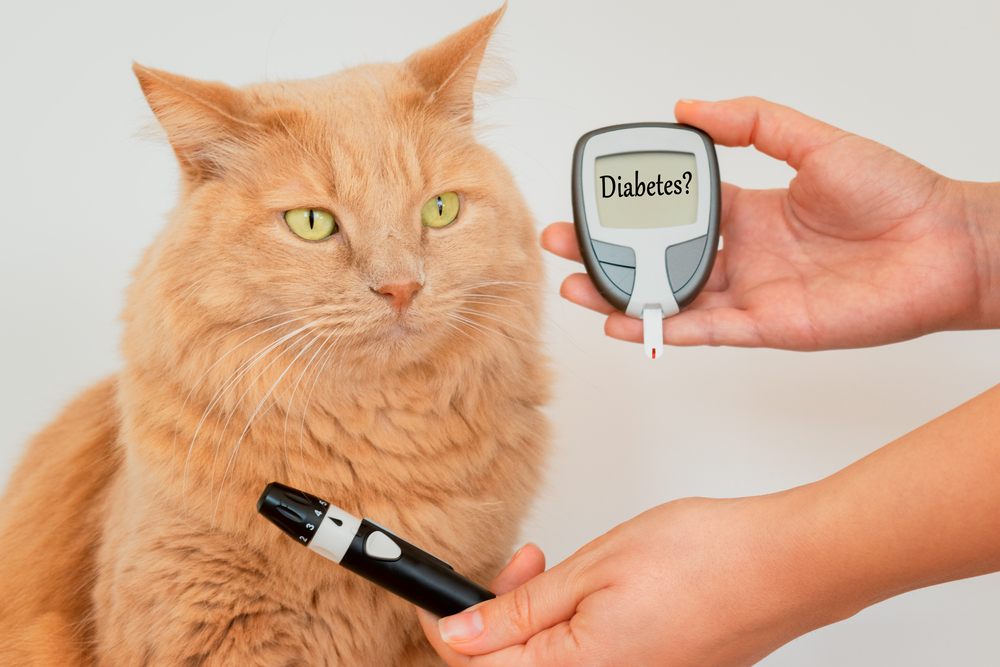Diabetes mellitus occurs in our pets when their body does not use glucose (sugars) normally. Glucose is used in the body for energy and is regulated by the pancreas sending out a hormone called insulin. Insulin is required to transfer the glucose to the cells. This becomes similar to a lock and key situation. The glucose is the lock and the insulin is the key. If the insulin is unable to be used or there is not enough circulating in the bloodstream (basically the wrong key) then the glucose will remain locked in the wrong places of the body such as the bloodstream which eventually will overflow into the urine if not treated. This is what causes diabetic pets to drink and urinate more. If the body is not getting enough energy then it must take it from somewhere else such as fat and muscle which is why pets will lose weight with untreated diabetes.
Do they have Type I or Type II?
Type I diabetes: Pancreas produces no insulin at all.
Type II diabetes: Pancreas produces some insulin, but not enough.
Almost all dogs have type I diabetes and must be treated with insulin. Most cats will have non-insulin-dependent diabetes or Type II.
How does it affect my cat or dog?
Cat:
- Type II
- Might not be permanent (Can go into remission)
- High Protein/Low Carb Diets
Dog:
- Type I
- Is permanent
- High Fiber Diets
- Can develop cataracts
How can I tell if my pet is diabetic?
- Excessive water drinking and increased urination
- Weight loss, even though there may be an increased appetite
- Cloudy eyes (especially in dogs)
- Chronic or recurring infections (including skin infections and urinary infections)
Did I do something to cause this?
Most likely no you did not. However, animals that are obese have a higher chance of becoming diabetic. Therefore making sure your friend doesn’t become overweight is the best thing you can do.
What can I do to help my pet?
The first thing you want to do for your possibly diabetic friend is to bring him to a veterinarian. They can do a glucose check if they feel that might be the case. This is the most important thing for them because the earlier you catch it the better chance of continuing a long life they will have. After a diagnosis, they will need to be on insulin and go to their vet for regular blood glucose curves (every 6 months once stable). This part is also important because it will tell us where the highs and lows are during the day which will give us important information for adjusting the insulin doses as soon as possible as too little is a problem but too much is an emergency called Hypoglycemia.
What is Hypoglycemia & why is it dangerous?
Hypoglycemia is the opposite of high blood sugar. Meaning that their sugars are too low. Having high blood sugars may be a problem but having too low blood sugar can be fatal! This is what you want to prevent. When watching your friend and making sure they don’t become hypoglycemic you want to look for the following things:
- lethargy (lack of energy)
- weakness
- head tilting
- hunger
- restlessness
- shivering
- ataxia – usually lack of muscular coordination, but maybe changes in head and neck movements, wobbling when walking, unbalanced
- disorientation
- stupor
- convulsions or seizures
- coma
If you notice anything like this. Your 1st step is to get them some corn syrup on their gums followed by giving them some food if it is safe to do so. Then get them to your nearest veterinary clinic.
My first curve
When newly diagnosed with diabetes your pet will need a glucose curve after 2-3 weeks. This is because all pets start on the average dose of insulin. Since each animal is different and there is no test to tell us how much is needed exactly, we have to do curves to get the correct dosing. So for the first little while, you may have to do a couple of these to get your stable dosing.
Can my curves be done at home?
Once your pet is on a stable dose yes you can do these curves at home! Make sure it is a day you will be home for at least 12 hours. You can purchase a glucometer from your veterinarian called AlphaTrak. The glucometer you use CAN NOT be one for humans! Then starting in the morning (after your pet has been fed and given insulin) you will take small drops of blood samples every 2-3 hours while recording the times the sample was taken, if insulin was given, and any food or treats. You can do this with a sheet that you can find here, this website or you can use this app called Pet Diabetes Tracker or Pet Dialog. Then after the day is done you can send the files to your veterinarian and they will be able to tell you if you need to change dosing.
Pet Diabetes Vs Human Diabetes
There are many similarities between pet diabetes vs human. However, it is important to understand the differences. First pets need to eat before getting insulin while humans get insulin after eating. Pets have 3 locations where you can give injections; between shoulder blades, flank, and the side of the chest. While humans can inject in 6 places; abdomen, upper arm, thigh, lower back, hips, or buttocks.
References:
AMVA – https://www.avma.org/resources/pet-owners/petcare/diabetes-pets
VCA – https://vcacanada.com/know-your-pet/diabetes-mellitus-in-dogs-overview
Vetsulin – https://www.vetsulin.com/
Veterinary Partner – https://veterinarypartner.vin.com/doc/?id=4951506
By: Ashley G, VT
